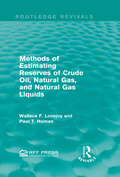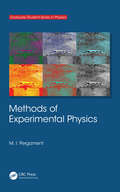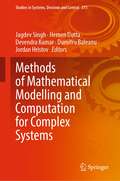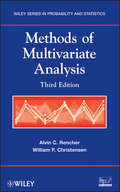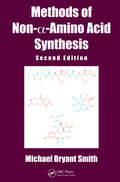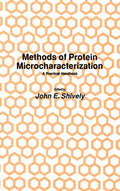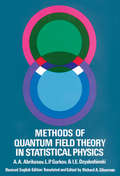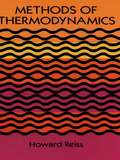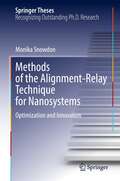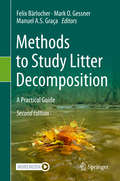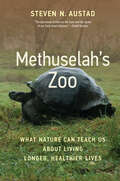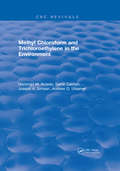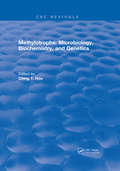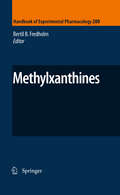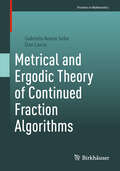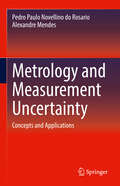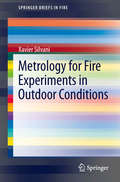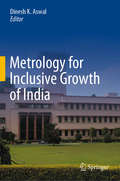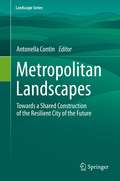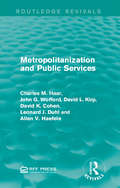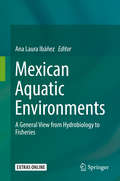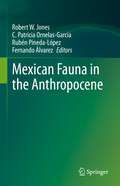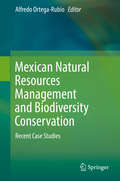- Table View
- List View
Methods of Estimating Reserves of Crude Oil, Natural Gas, and Natural Gas Liquids (Routledge Revivals)
by Wallace F. Lovejoy Paul T. HomanMethods of Estimating Reserves of Crude Oil, Natural Gas, and Natural Gas Liquids, first published in 1965, aims to throw new light on a field of knowledge vital to consideration of problems of public policy regarding future sources of energy. This book will be of interest to students of environmental studies.
Methods of Experimental Physics (Graduate Student Series in Physics)
by M. I. PergamentBased on the modern approach of information theory, this book presents novel experimental techniques, tools, and data processing methods for physics applications. It shows readers how to plan and conduct experiments, design and certify measuring equipment, and process and interpret the experimental data. Drawing on his extensive experience in exper
Methods of Mathematical Modelling and Computation for Complex Systems (Studies in Systems, Decision and Control #373)
by Dumitru Baleanu Hemen Dutta Devendra Kumar Jagdev Singh Jordan HristovThis book contains several contemporary topics in the areas of mathematical modelling and computation for complex systems. The readers find several new mathematical methods, mathematical models and computational techniques having significant relevance in studying various complex systems. The chapters aim to enrich the understanding of topics presented by carefully discussing the associated problems and issues, possible solutions and their applications or relevance in other scientific areas of study and research. The book is a valuable resource for graduate students, researchers and educators in understanding and studying various new aspects associated with complex systems. Key Feature • The chapters include theory and application in a mix and balanced way. • Readers find reasonable details of developments concerning a topic included in this book. • The text is emphasized to present in self-contained manner with inclusion of new research problems and questions.
Methods of Molecular Analysis in the Life Sciences
by Malcolm Jones Andreas Hofmann Anne Simon Tanja Grkovic Andreas Hofmann Anne Simon Tanja GrkovicDelivering fundamental insights into the most popular methods of molecular analysis, this text is an invaluable resource for students and researchers. It encompasses an extensive range of spectroscopic and spectrometric techniques used for molecular analysis in the life sciences, especially in the elucidation of the structure and function of biological molecules. Covering the range of up-to-date methodologies from everyday mass spectrometry and centrifugation to the more probing X-ray crystallography and surface-sensitive techniques, the book is intended for undergraduates starting out in the laboratory and for more advanced postgraduates pursuing complex research goals. The comprehensive text provides strong emphasis on the background principles of each method, including equations where they are of integral importance to the individual techniques. With sections on all the major procedures for analysing biological molecules, this book will serve as a useful guide across a range of fields, from new drug discovery to forensics and environmental studies.
Methods of Multivariate Analysis
by William F. Christensen Alvin C. RencherPraise for the Second Edition"This book is a systematic, well-written, well-organized text on multivariate analysis packed with intuition and insight . . . There is much practical wisdom in this book that is hard to find elsewhere."-IIE TransactionsFilled with new and timely content, Methods of Multivariate Analysis, Third Edition provides examples and exercises based on more than sixty real data sets from a wide variety of scientific fields. It takes a "methods" approach to the subject, placing an emphasis on how students and practitioners can employ multivariate analysis in real-life situations.This Third Edition continues to explore the key descriptive and inferential procedures that result from multivariate analysis. Following a brief overview of the topic, the book goes on to review the fundamentals of matrix algebra, sampling from multivariate populations, and the extension of common univariate statistical procedures (including t-tests, analysis of variance, and multiple regression) to analogous multivariate techniques that involve several dependent variables. The latter half of the book describes statistical tools that are uniquely multivariate in nature, including procedures for discriminating among groups, characterizing low-dimensional latent structure in high-dimensional data, identifying clusters in data, and graphically illustrating relationships in low-dimensional space. In addition, the authors explore a wealth of newly added topics, including:Confirmatory Factor AnalysisClassification TreesDynamic GraphicsTransformations to NormalityPrediction for Multivariate Multiple RegressionKronecker Products and Vec NotationNew exercises have been added throughout the book, allowing readers to test their comprehension of the presented material. Detailed appendices provide partial solutions as well as supplemental tables, and an accompanying FTP site features the book's data sets and related SAS® code.Requiring only a basic background in statistics, Methods of Multivariate Analysis, Third Edition is an excellent book for courses on multivariate analysis and applied statistics at the upper-undergraduate and graduate levels. The book also serves as a valuable reference for both statisticians and researchers across a wide variety of disciplines.
Methods of Non-a-Amino Acid Synthesis
by Michael Bryant SmithAlthough less common than a-amino acids, non-a-amino acids-where the amino group is not on the carbon immediately adjacent to the carboxyl group but is attached to another carbon in the chain (for example, the � , d carbon)-are components of biologically important molecules, are significant in the pharmaceutical industry, and are useful starting ma
Methods of Protein Microcharacterization
by John E. ShivelyMethods of Protein Microcharacterization
Methods of Quantum Field Theory in Statistical Physics
by Richard A. Silverman L. P. Gorkov I. E. Dzyaloshinski A. A. AbrikosovThis comprehensive introduction to the many-body theory was written by three renowned physicists and acclaimed by American Scientist as "a classic text on field theoretic methods in statistical physics."
Methods of Small Parameter in Mathematical Biology
by Jacek Banasiak Mirosław LachowiczThis monograph presents new tools for modeling multiscale biological processes. Natural processes are usually driven by mechanisms widely differing from each other in the time or space scale at which they operate and thus should be described by appropriate multiscale models. However, looking at all such scales simultaneously is often infeasible, costly, and provides information that is redundant for a particular application. Hence, there has been a growing interest in providing a more focused description of multiscale processes by aggregating variables in a way that is relevant to the purpose at hand and preserves the salient features of the dynamics. Many ad hoc methods have been devised, and the aim of this book is to present a systematic way of deriving the so-called limit equations for such aggregated variables and ensuring that the coefficients of these equations encapsulate the relevant information from the discarded levels of description. Since any approximation is only valid if an estimate of the incurred error is available, the tools the authors describe allow for proving that the solutions to the original multiscale family of equations converge to the solution of the limit equation if the relevant parameter converges to its critical value The chapters are arranged according to the mathematical complexity of the analysis, from systems of ordinary linear differential equations, through nonlinear ordinary differential equations, to linear and nonlinear partial differential equations. Many chapters begin with a survey of mathematical techniques needed for the analysis. All problems discussed in this book belong to the class of singularly perturbed problems; that is, problems in which the structure of the limit equation is significantly different from that of the multiscale model. Such problems appear in all areas of science and can be attacked using many techniques Methods of Small Parameter in Mathematical Biology will appeal to senior undergraduate and graduate students in applied and biomathematics, as well as researchers specializing in differential equations and asymptotic analysis.
Methods of Thermodynamics
by Howard ReissSince there is no shortage of excellent general books on elementary thermodynamics, this book takes a different approach, focusing attention on the problem areas of understanding of concept and especially on the overwhelming but usually hidden role of "constraints" in thermodynamics, as well as on the lucid exposition of the significance, construction, and use (in the case of arbitrary systems) of the thermodynamic potential. It will be especially useful as an auxiliary text to be used along with any standard treatment.Unlike some texts, Methods of Thermodynamics does not use statistical mechanics as a crutch to explain the subject. In the author's view, the student should learn to use the method of themodynamics in all its power, applying it to any problem it may help solve. As the author states: "In view of the high level of confidence which we place in thermodynamics, what is known thermodynamically is often considered to be known once and for all...by restricting oneself initially to purely thermodynamic arguments, one can know what he does know before entering domains where conclusions are less certain."Major chapter headings in this volume include: mathematical apparatus, the first law of thermodynamics, the second law and entropy, ideal substances, some useful formulas, internal equilibrium, and the extremal properties of the entropy, thermodynamic potentials, phase equilibria in simple systems, osmotic systems, systems which may perform surface work, systems in gravitational and centrifugal fields, elastic systems, stability, and third law. 1965 edition.
Methods of the Alignment-Relay Technique for Nanosystems: Optimization and Innovation (Springer Theses)
by Monika SnowdonThis thesis addresses the problem of improving the alignment of carbon nanotubes (CNTs) in transistor applications, taking a unique approach using iptycenes acting as molecular tweezers in combination with a liquid crystal solvent. As part of a project to test the effectiveness of a multi-step method, the so-called Alignment Relay Technique (ART), this work contributed evidence for the selectivity and stability of ART, as well as providing the first proof-of-concept that ART can be used to create CNT field-effect transistors (FETs). The thesis effectively explains and illustrates the chemical synthesis of the tweezers, the concept and actualization of the technique, the various factors observed to influence deposition and selectivity, along with material fabrication using both photolithography and electron beam lithography. This research advances knowledge of transistors and expands the applications of small organic molecules in the field of materials science. Particular highlights of this thesis include: an extensive review of ART, its advantages, and limitations; development of new material chemistry methods for the optimization of semiconducting CNT selectivity; and a comprehensive exploration of fabrication and characterization of CNTFETs for future applications.
Methods to Study Litter Decomposition: A Practical Guide
by Felix Bärlocher Mark O. Gessner Manuel A. S. GraçaThe primary objective of this book is to provide students and laboratory instructors at universities and professional ecologists with a broad range of established methods to study plant litter decomposition. Detailed protocols for direct use in the field or laboratory are presented in an easy to follow step-by-step format. A short introduction to each protocol reviews the ecological significance and principles of the technique and points to key references.
Methuselah's Zoo: What Nature Can Teach Us about Living Longer, Healthier Lives
by Steven N. AustadStories of long-lived animal species—from thousand-year-old tubeworms to 400-year-old sharks—and what they might teach us about human health and longevity.Opossums in the wild don&’t make it to the age of three; our pet cats can live for a decade and a half; cicadas live for seventeen years (spending most of them underground). Whales, however, can live for two centuries and tubeworms for several millennia. Meanwhile, human life expectancy tops out around the mid-eighties, with some outliers living past 100 or even 110. Is there anything humans can learn from the exceptional longevity of some animals in the wild? In Methusaleh&’s Zoo, Steven Austad tells the stories of some extraordinary animals, considering why, for example, animal species that fly live longer than earthbound species and why animals found in the ocean live longest of all. Austad—the leading authority on longevity in animals—argues that the best way we will learn from these long-lived animals is by studying them in the wild. Accordingly, he proceeds habitat by habitat, examining animals that spend most of their lives in the air, comparing insects, birds, and bats; animals that live on, and under, the ground—from mole rats to elephants; and animals that live in the sea, including quahogs, carp, and dolphins. Humans have dramatically increased their lifespan with only a limited increase in healthspan; we&’re more and more prone to diseases as we grow older. By contrast, these species have successfully avoided both environmental hazards and the depredations of aging. Can we be more like them?
Methyl Chloroform and Trichloroethylene in the Environment
by D. M. AviadoIn the present and subsequent volumes of this book, critical coverage of the literature will be combined with the fruits of original and highly relevant research carried out by Dr. D.M Aviado and his colleagues. The total effort constitutes an authoritative up-to-date appraisal of the knowledge needed to understand the inhalational toxicity and other biological effects of an important and ubiquitous class of chemical agents.
Methylotrophs: Microbiology, Biochemistry And Genetics
by HouThis book offers a comprehensive examination of the microbiology, biochemistry, genetics, and applied aspects of methylotrophsThis book is intended for reference purposes at the professional level and for students at the graduate level. It is hoped that it will provide researchers with not only basic science, but also applied aspects of methylotrophs.
Methylxanthines
by Bertil B. FredholmIn the present volume of the Handbook of Experimental Pharmacology well known experts describe the actions of different xanthines with a focus on caffeine and theophylline. A special chapter is devoted to theobromine, an active component of chocolate, the actions of which are less well characterized. This book also presents the pharmacology of one xanthine derivative, propentofylline, as an example of a xanthine that has gone through extensive development for a novel therapeutic area.
Metrical and Ergodic Theory of Continued Fraction Algorithms (Frontiers in Mathematics)
by Gabriela Ileana Sebe Dan LascuThis monograph presents the work of the authors in metrical theory of continued fractions in the last two decades. The monograph cuts a particular path through this extensive theory and describes the theory in its current form for three families of continued fractions, namely, θ-continued fractions, N-continued fractions, and generalized Rényi continued fractions. The book systematically lays out the required preliminaries, making the book easy to read. This monograph provides a solid introduction into the theory of continued fractions. The book is intended for researchers in metrical theory, as well as advanced graduate students and mathematicians interested in this field.
Metrology and Measurement Uncertainty: Concepts and Applications
by Alexandre Mendes Pedro Paulo Novellino do RosarioThis book presents in a clear, didactic, and straightforward manner, the concepts, tools and technical terminology needed to understand metrological issues in industry and laboratories. Using examples of calibration and detailed critical analysis of the certificates, the book explores metrology and measurement uncertainty, both concepts and applications; mathematical foundations, statistical tools, techniques, practices, and the operational procedures that make up metrology. The text is based on the most recent editions of the International Vocabulary of Metrology, the International System of Units and the Guide to the Expression of Measurement Uncertainty.
Metrology for Fire Experiments in Outdoor Conditions
by Xavier SilvaniNatural fires can be considered as scale-dependant, non-linear processes of mass, momentum and heat transport, resulting from a turbulent reactive and radiative fluid medium flowing over a complex medium, the vegetal fuel. In natural outdoor conditions, the experimental study of natural fires at real scale needs the development of an original metrology, one able to capture the large range of time and length scales involved in its dynamic nature and also able to resist the thermal, mechanical and chemical aggression of flames on devices. Robust, accurate and poorly intrusive tools must be carefully set-up and used for gaining very fluctuating data over long periods. These signals also need the development of original post-processing tools that take into account the non-steady nature of their stochastic components. Metrology for Fire Experiments in Outdoor Conditions closely analyzes these features, and also describes measurements techniques, the thermal insulation of fragile electronic systems, data acquisition, measurement errors and optimal post-processing algorithms. This book is intended for practitioners as a reference guide for optimizing measurements techniques in an outdoor environment. Advanced-level students and researchers will also find the book invaluable.
Metrology for Inclusive Growth of India
by Dinesh K. AswalThis book describes the significance of metrology for inclusive growth in India and explains its application in the areas of physical–mechanical engineering, electrical and electronics, Indian standard time measurements, electromagnetic radiation, environment, biomedical, materials and Bhartiya Nirdeshak Dravyas (BND®). Using the framework of “Aswal Model”, it connects the metrology, in association with accreditation and standards, to the areas of science and technology, government and regulatory agencies, civil society and media, and various other industries. It presents critical analyses of the contributions made by CSIR-National Physical Laboratory (CSIR-NPL), India, through its world-class science and apex measurement facilities of international equivalence in the areas of industrial growth, strategic sector growth, environmental protection, cybersecurity, sustainable energy, affordable health, international trade, policy-making, etc. The book will be useful for science and engineering students, researchers, policymakers and entrepreneurs.
Metropolitan Landscapes: Towards a Shared Construction of the Resilient City of the Future (Landscape Series #28)
by Antonella ContinThis edited volume covers many aspects of the Metropolitan Landscapes. Solutions are needed to meet the demand of the citizens of a renewed metropolitan region landscape. It opens up discussions about possible toolkits for strategic actions based on understanding the territory from geographical, urban, architectural, economic, environmental, and public policy perspectives. This book intends to promote the Metropolitan dwelling quality, ensuring human well-being proposing a discussion on the resilient articulation of the interface space among the city's infrastructure, agriculture, and nature.This book results from the Symposium: Metropolitan Landscapes that MSLab of the Politecnico di Milano and ETSA (Sevilla) organized at the IALE 2019 Conference (Milan, July 2019) to manage radical territory transformation with a strategic vision. The widespread growth of urban areas indicates the importance of building resilient sustainable cities capable of minimizing climate-change impact production.The Symposium aimed to discuss the Urban Metabolism approach considering the combination of Landscapes set in a single Metropolitan Ecosystem. Accordingly, new design strategies of transformation, replacement or maintenance can compose Urban-Rural Linkage patterns and a decalage of different landscape contexts. Ecological interest in environmental sustainability, compatibility, and resilience is not tied exclusively to the balance between production and energy consumption. Thus, it is the integration over time and at several scales of the urban and rural landscapes and their inhabitants that nourish the Metropolitan Bioregion.Moreover, the Metropolitan Landscape Book's research hypothesis is the need for a Glossary, strengthening the basis of understanding Metropolitan Landscape's complexity.This book's topic is particularly relevant to Landscape Urbanism, Architecture, Urban disciplines Scholars, Students and Practitioners who want to be connected in a significant way with Metropolitan Discipline’s research field.
Metropolitanization and Public Services (Routledge Revivals)
by David K. Cohen David L. Kirp Charles M. Haar John G. Wofford Leonard J. Duhl Allen V. HaefeleMetropolitanization and Public Services is third in a series on the governance of metropolitan regions which aims to explore the welfare and development of Metropolitan America. Originally published in 1972, this study discusses who decides which essential public services need to be provided within a metropolitan area by looking at political reform as well as presenting ideas on functional efficiency, costs and benefits and the effectiveness of the political process. This title will be of interest to students of environmental studies.
Mexican Aquatic Environments: A General View from Hydrobiology to Fisheries
by Ana Laura IbáñezPursuing a multidisciplinary approach, this book highlights current challenges in, and potential solutions to, environmental water management in Mexico. It includes an essential review of current literature and state of the art research, providing a one-stop resource for researchers, graduate students and environmental water managers alike. The result of a cooperation between 35 researchers from seven Mexican academic institutions, two Federal Commissions and one international organization, the book links science to practice for living organisms and their environment, while also addressing anthropogenic effects on our water ecosystems. Particularly the book addresses the following subjects: Biodiversity in inland waters, physical and chemical characterization of inland waters, physico-chemical characterization of Mexican coastal lagoons, microbiota in brackish ecosystems, diversity associated with southern Mexico’s pacific coral reefs, fry fish stockings in aquatic epicontinental systems, a review of tuna fisheries in Mexico, fishery resource management challenges stemming from climate change, aquatic invasive alien species, harmful algal blooms, and aquatic protected areas, related ecological and social problems and the importance for fisheries’ yield.
Mexican Fauna in the Anthropocene
by Robert W. Jones C. Patricia Ornelas-García Rubén Pineda-López Fernando ÁlavarezThis contributed volume presents an analysis of the current conservation status of major faunal groups in Mexico. The chapters describe a prognosis of future challenges, and also explore the expanding threats inherent in the Anthropocene within the context of the unique physical, biological and cultural aspects of the nation. Covering 27 chapters, and written by Mexican and international authors, this book analyzes a wide range of vertebrate and invertebrate animal taxa, their ecosystems and the critical processes related to their present conservation status. This volume is an important reference material for researchers, conservationists and students interested in the biological and ecological processes shaping the Mexican fauna.
Mexican Natural Resources Management and Biodiversity Conservation: Recent Case Studies
by Alfredo Ortega-RubioThis book presents valuable and recent lessons learned regarding the links between natural resources management, from a Socio-Ecological perspective, and the biodiversity conservation in Mexico. It address the political and social aspects, as well as the biological and ecological factors, involved in natural resources management and their impacts on biodiversity conservation. It is a useful resource for researchers and professionals around the globe, but especially those in Latin American countries, which are grappling with the same Bio-Cultural heritage conservation issues.
